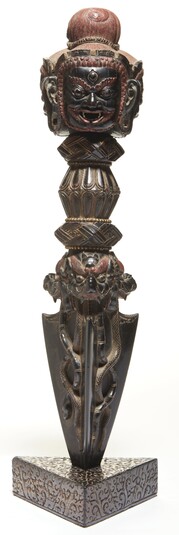
Item: Ritual Object - Purba (peg)
| Origin Location | China |
|---|---|
| Date Range | 1400 - 1499 |
| Lineages | Buddhist |
| Size | 42cm (16.54in) high |
| Material | Wood, Painted Face/Hair |
| Collection | Private |
Classification: Object/Concept
Kila (purba, peg).
A purba (Tibetan: phur ba. Sanskrit: kila) is a three edged peg usually made from metal or wood. They are sometimes described as daggers with three blades. The best of the metal ones from a Tantric Buddhist point of view are constructed from meteorite iron. Sandalwood is also popular. Various ritual texts may also specify a specific substance or medium for the specialized magical application. The principal deity associated with the purba is Vajrakila. These purbas generally have three faces at the top and crowned with a half vajra. Alternately a specific type of purba is connected with the practice of Hayagriva. This purba has a horse head at the top rather than a half vajra, although it should be noted that in Hayagriva's iconographic depictions he does not hold a purba. The Nyingma lamas Dorje Dudjom and Jatson Nyingpo are generally shown with the left hand thrusting a purba downward. The Bon religion also uses the purba as a deity, Purba Drugse Chempa, and a ritual object. These Bon ritual objects can generally be identified as having multiple heads with the top crowned with a garuda - the king of birds along with a total absence of a full or half vajra. See Purba bibliography.
Jeff Watt 3-2002 [updated 2-2019]
The ritual use of this powerful object is explicated in the Vajrakilaya Tantra, a system of practice perfected and transmitted by the deified historical figure, Padmasambhava, who is accredited with the import of Buddhism to Tibet in the eighth century and the consecration of Samye, the first Buddhist monastery in Tibet. Tibetan Buddhist practitioners use this sacred text in conjunction with this ritual peg, or phurba, to ward off demonic obstructions and to protect the religion in the tradition established by early Vajrayana practitioners, or nyingmapa, who carried traditions from India to Tibet.
The heads of the three wrathful heruka that sit at the top of this imposing ritual device symbolize the instrument’s ritual potency as an embodiment of the blood-drinking deity, Vajrakilaya. Carved from rare and expensive ebony, known in Chinese as wumu, and formerly inlaid with large earrings and rows of teeth made of ivory, this large phurba was evidently created with the vision of an efficacious, yet aesthetically-imposing ceremonial tool. The use of luxury materials make it likely that this was an imperial commission - a gift from a royal court to an esteemed Tibetan lama. Moreover, the present work is the highest in quality among a very few examples of this type. Other iterations of this style can be found in the collections of the Rubin Museum of Art, New York, and in the Musée Guimet, Paris. Neither, however, matches the quality of this exceptionally refined example.
With such a scarcity of examples and primary sources to utilize, few scholars have invested in this subject, leaving much to be discovered. The Rubin Museum example has been dated variously as fourteenth century in the current exhibition at the Rubin Museum of Art, Second Buddha: Master of Time, curated by Elena Pakhoutova, and as seventeenth century in the 2007 exhibition BIG: Himalayan Art, also at the Rubin Museum of Art, curated by Jeff Watt. Others opine that the group could be seventeenth or eighteenth century commissions by the court of the Qing emperors. The Musée Guimet example, which differs in that it bears two painted faces, is published by J. Auboyer as seventeenth-eighteenth century in Dieux et de´mons de l'Himalaya, Paris, 1977, p. 261, no. 317. As Yuan, Ming, and Qing emperors maintained close relationships with Tibetan lamas of the Sakya tradition—the most likely institution to house an object like this, as the sect with the greatest emphasis upon the tutelary deity or yidam, Vajrakilaya—it is unreasonable to make a politically grounded argument for one of these various attributions.
The present phurba has hitherto been described as a fourteenth-century object of Tibetan origin. Robert A. F. Thurman and David Weldon support this attribution in Sacred Symbols: The Ritual Art of Tibet, Sotheby's, New York, 1999, and again, in The Metropolitan Museum of Art’s 2010 exhibition, Rugs and Ritual in Tibetan Buddhism, by way of comparison to a stone stele of Panjarnata Mahakala, dated by inscription to 1292, at the Musée Guimet. The striking facial features certainly relate to the corpus of works carried out during the Yuan dynasty (1279-1368), when the influence of Newar artisanship was at an all-time high in China and its environs. However, one cannot ignore strong stylistic similarities between the present example and Yongle-period bronze iterations, such as the inscribed example sold by Sotheby’s, Hong Kong, 8 April 2014, lot 3056, which David Weldon, in Sacred Symbols: The Ritual Art of Tibet, likened to a group of Yongle-commissioned phurba gifted to and stored at Sakya Monastery in Central Tibet. Woodblock illustrations of wrathful deities in the Tshalpa Kangyur xylograph printed in Beijing in 1410 share these features, as well.
Provenance: Rossi & Rossi, New York, 1999. The Irving Collection, no. 3869.
Laura A. Weinstein, 1-2019
Collection: Christie's, New York (Sculpture. March, 2019)
Thematic Sets
Ritual Object: Kila Examples (Size & Function)
Ritual Object: Kila Examples (Decorative)
Exhibition: Mandalas, Mapping the Buddhist Art of Tibet (Sculpture)
Ritual Object: Kila 'Purba' (Masterworks)
Ritual Object: Kila 'Purba' Main Page
Ritual Object: Kila 'Purba' (Peg, Wood)
Ritual Object: Kila 'Purba' (Black Wood)
